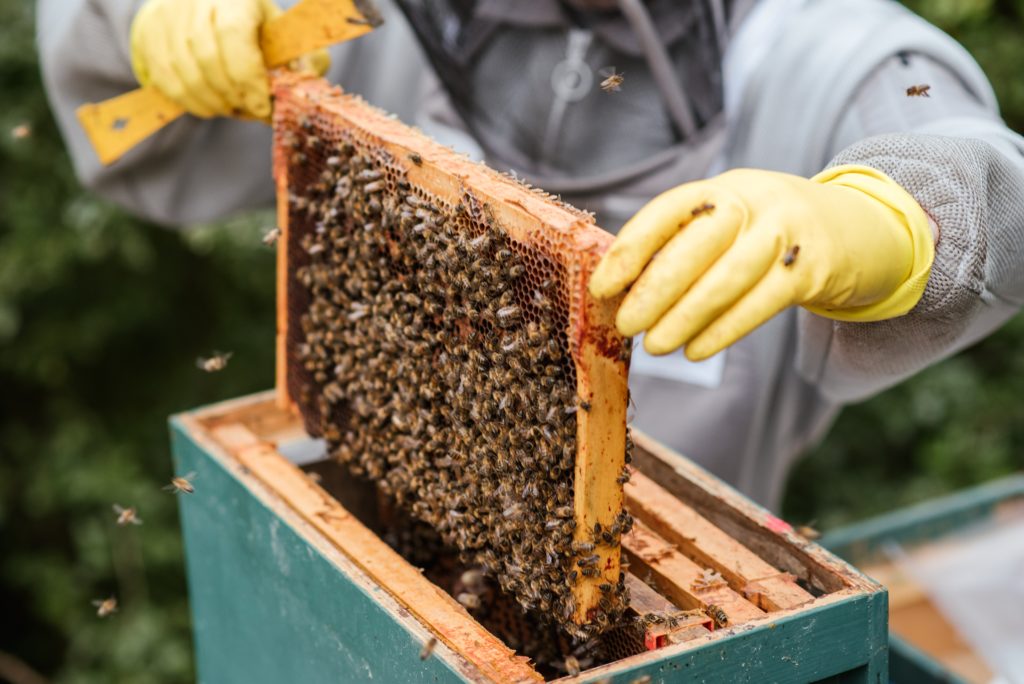
It is probably known to everyone that the population growth is constantly increasing. A less obvious consequence is that as a result there are also more and more pets. This, of course, makes it necessary to feed them adequately. Just about every owner cares about the well-being of his/her animal companion and wants to give them a long and healthy life. To make this possible, high-quality and nutrient-rich food sources are needed that also conserve the earth’s resources to allow for sustainable coexistence.
This is exactly where algae come into play. They offer environmentally friendly and vegetarian alternatives to conventional ingredients and can thus contribute to animal welfare. How can algae pet food do its part to help animals live longer, healthier lives?

Algae pet food for dogs & cats
In 2020 alone, the number of pets in German households was estimated at approximately 35 million. Dogs (10.7 million) and cats (15.7 million) clearly represent the majority of pets that need to be fed.
Nowadays, many people can no longer imagine their lives without them and they are an essential part of everyday life and even of the family. It is therefore not surprising that the pet food industry, considering the ever-increasing number of pets, is always looking for innovative, healthy and efficient sources of nutrients.
In the field of microalgae for pet food, Spirulina and Chlorella in particular are widely used as nutrient-rich alternatives and have been well researched. These algae provide an alternative for protein from soybean sprouts, thus indirectly saving the environment by clearing less natural land for agricultural purposes. In addition, algae can photosynthetically absorb CO2, producing oxygen and biomass just like soy beans but in bigger volumes.
In the process, production is even more sustainable because it requires less fossil fuel, relies less on fertilizers, and does not use pesticides. Energy consumption can be very low because microalgae only need a constant flow of water, and the minerals it contains, as well as sun and CO2 to thrive and photosynthesize.
Spirulina and Chlorella are ideal examples of microalgae whose nutrient profiles contain the macro- and micronutrients essential for animals and humans. In doing so, they meet the extensive requirements as they contain protein, antioxidants, vitamins (among others B12, B6, B3, D, & A), fiber, trace elements (among others Phosphorous, Magnesium, Iron) and fatty acids (DHA & EPA), all of which contribute to a balanced and efficient diet for pets and promote health.
The secondary effects, which are in addition to the nutrients already listed, are not to be underestimated, and can in themselves be the incentive to include microalgae in pet food. Due to the probiotic properties, the addition of algae allows for a more active immune system, improvement of intestinal health, oral hygiene and that of the shine and strength of the coat. Even the risk of cancer can be preventively reduced, due to the fact that the antioxidants in Spirulina and Chlorella protect against free radicals. Chlorella in particular is known to assist in the detoxification process, as it binds toxins in the body, which can then be eliminated.
Especially in old age, health problems accumulate in humans and animals, as the body and its functions become more and more limited. Omega-3 DHA supplemented food can improve and promote cognitive abilities in ageing animals, this also in humans. Especially in older dogs, omega-3 fatty acids from algae oil (Schizochytrium) can have the positive effect of improving the absorption of other nutrients, which becomes increasingly difficult with age.
Microalgae, especially Spirulina and Chlorella, can contribute to the health of our four-legged friends and give them the longest possible life, which they can enjoy together with the pet owners.

Algae pet food source for bees
Malnutrition in bees can lead to far-reaching consequences. The loss of the entire bee colony can be the result, as the harmful effects of parasites, pathogens and pesticides have an even more devastating effect on weakened bees. Habitat loss is a result of bee mortality, as pollinators play a vital role in the ecosystem. So the decline in the diversity of flowering plants may be one impact. However, bee mortality is not only a problem for the wild, but also for the large-scale monocultures of agriculture. Without pollinators, harvests and thus yields fail, which in turn affects us humans.
Currently available food for bees consists mainly of: Soy, wheat, yeast, lentils and milk proteins, many of which do not have a particularly environmentally friendly eco-balance and do not all provide essential nutrients. It is in this aspect that Spirulina and Chlorella can offer new solutions, and make bee nutrition more balanced.
Microalgae can play a major role in supporting bee colonies as a supplement to existing pollen substitutes. In concrete terms, this means that they do not replace them completely, but play a complementary role to optimize the already known pollen substitutes. Compared to pollen, Spirulina has a similar nutrient profile with abundant amino acids and fats that are essential for the immune system and protein synthesis of bees, thus enabling healthy colony growth. Studies conducted with Chlorella as a food supplement have shown that it stimulated the production of bee brood.
What is also important to mention is that Spirulina can be grown in controlled systems (photobioreactors) where they are free from pollutants, toxins and pesticides. So these are not contained and therefore cannot have a negative effect on the bees. In modern beekeeping, pollen substitutes are increasingly in demand, serving as a suitable alternative to natural nectar sources, which unfortunately are increasingly disappearing. Natural nutrition for bees is thus becoming increasingly difficult in some regions due to the shortage of pollen.
When selecting pollen substitutes, special attention should be paid to their high quality, as well as their environmentally friendly, resource-saving production, in order not to further aggravate the previously mentioned problem of species decline due to agriculture. Mainly in bee larvae one could prove after feeding with Chlorella clearly increased values of lipids, which supplies among other things important energy reserves. Increased honey production, as well as the expansion of bee colonies are among the results from studies that are particularly noteworthy.
Microalgae can therefore play a major role in the supplementation of bee nutrition, and thus help to counteract bee mortality. This has far-reaching consequences on the entire ecosystem and the diversity of flora and fauna, which is vital for humans and animals.

Algae pet food for horses
Horses are not pets in the traditional sense, but since they are very rarely kept for farm work, and are more likely to be found in private livestock, we include them here as pets.
Trace elements, minerals and micronutrients, including amino acids, play a major role in supporting the health and performance of horses. Especially when access to fresh pasture grass is not possible, i.e. in winter, a balanced feed source is particularly important for horses, as they cannot produce these substances themselves in the body. Compared to microalgae, hay does not have enzymes, so even high quality hay quickly loses its vitamin content in the process of drying. To this end, algae like the ones from the genera Spirulina, Chlorella and Schizochytrium can offer a varied and natural addition to the usual options of feed.
Studies from the University of Florida’s Department of Animal Sciences suggest that omega-3 polyunsaturated fatty acids ingested with algae animal feed can reduce inflammation and thus improve recovery in active horses. The microalgae Schizochytrium in powder and/or oil is of particular interest as it is one of the most important vegetarian sources of omega-3 DHA and EPA.
Another interesting microalgae is Chlorella vulgaris, which contains many vitamins, chlorophyll and other trace elements. With its high protein content of up to 60%, Chlorella is a high quality and efficient source of protein that can be easily absorbed by the animal through supplemented diets and can help especially young foals grow. With its high chlorophyll content and fibrous outer cell, Chlorella can increase the number of beneficial bacteria in the digestive tract and act as a probiotic, supporting the digestive system and consequently the immune system.
Probably the best known microalgae, Spirulina also has very useful properties as a supplement for horses. To list just a few of the scientifically proven benefits of a horse feed supplemented with Spirulina, these would include: Supporting respiratory function, improving blood flow and faster recovery after exercise. Spirulina is therefore the ideal supplement for animal feed of horses that are promoted athletically and whose performance is to be supported.
Conclusion
For pet owners, it is clear that animal welfare, and therefore health, is the most important thing. As a welcome side effect, the healthy diet with microalgae also has a positive impact on the visual appearance, a healthy animal looks accordingly healthy and beautiful. Algae are playing a growing role in pet food for pets, and in the future, the many benefits are sure to grow.
With sustainability and efficiency in mind, algae should not be underestimated as an interesting tool. They can help to reduce the burden on the environment, as well as provide more efficient and healthier pet food for pets.
We at Alganex are of course happy to advise and supply any partners in the pet food and animal feed industry in general, and do our part to improve animal husbandry inclusively for all.
References
https://link.springer.com/article/10.1007/BF02178573
https://www.derstandard.de/story/2000082382786/haustierfutter-schadet-umwelt-zunehmend
https://en.allextruded.com/entrada/what-are-microalgae-and-what-are-its-benefits-for-pets-24772
https://www.futuremarketinsights.com/reports/microalgae-pet-food-sector
https://www.ivh-online.de/der-verband/daten-fakten/anzahl-der-heimtiere-in-deutschland.html
https://madbarn.com/spirulina-benefits-for-horses/
https://www.quarks.de/umwelt/klimawandel/darum-sollten-wir-algen-lieben/




Comments by [email protected]